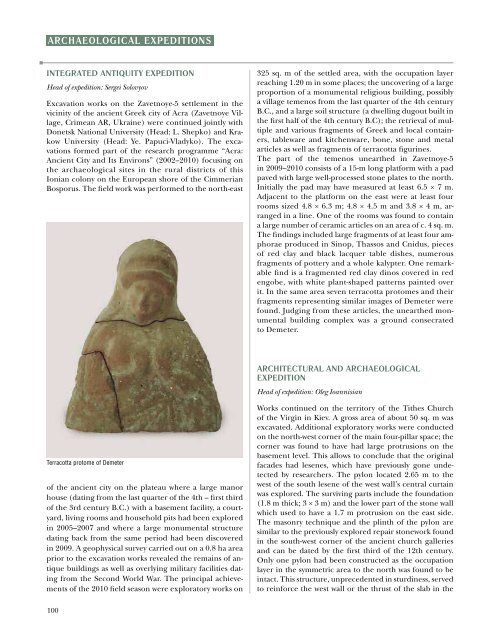The STaTe hermiTage muSeum annual reporT
The STaTe hermiTage muSeum annual reporT
The STaTe hermiTage muSeum annual reporT
You also want an ePaper? Increase the reach of your titles
YUMPU automatically turns print PDFs into web optimized ePapers that Google loves.
archaeological expediTionS<br />
inTegraTed anTiQuiTy expediTion<br />
Head of expedition: Sergei Solovyov<br />
Excavation works on the Zavetnoye-5 settlement in the<br />
vicinity of the ancient Greek city of Acra (Zavetnoye Village,<br />
Crimean AR, Ukraine) were continued jointly with<br />
Donetsk National University (Head: L. Shepko) and Krakow<br />
University (Head: Ye. Papuci-Vladyko). <strong>The</strong> excavations<br />
formed part of the research programme “Acra:<br />
Ancient City and Its Environs” (2002–2010) focusing on<br />
the archaeological sites in the rural districts of this<br />
Ionian colony on the European shore of the Cimmerian<br />
Bosporus. <strong>The</strong> field work was performed to the north-east<br />
Terracotta protome of Demeter<br />
of the ancient city on the plateau where a large manor<br />
house (dating from the last quarter of the 4th – first third<br />
of the 3rd century B.C.) with a basement facility, a courtyard,<br />
living rooms and household pits had been explored<br />
in 2005–2007 and where a large monumental structure<br />
dating back from the same period had been discovered<br />
in 2009. A geophysical survey carried out on a 0.8 ha area<br />
prior to the excavation works revealed the remains of antique<br />
buildings as well as overlying military facilities dating<br />
from the Second World War. <strong>The</strong> principal achievements<br />
of the 2010 field season were exploratory works on<br />
325 sq. m of the settled area, with the occupation layer<br />
reaching 1.20 m in some places; the uncovering of a large<br />
proportion of a monumental religious building, possibly<br />
a village temenos from the last quarter of the 4th century<br />
B.C., and a large soil structure (a dwelling dugout built in<br />
the first half of the 4th century B.C); the retrieval of multiple<br />
and various fragments of Greek and local containers,<br />
tableware and kitchenware, bone, stone and metal<br />
articles as well as fragments of terracotta figurines.<br />
<strong>The</strong> part of the temenos unearthed in Zavetnoye-5<br />
in 2009–2010 consists of a 15-m long platform with a pad<br />
paved with large well-processed stone plates to the north.<br />
Initially the pad may have measured at least 6.5 × 7 m.<br />
Adjacent to the platform on the east were at least four<br />
rooms sized 4.8 × 6.3 m; 4.8 × 4.5 m and 3.8 × 4 m, arranged<br />
in a line. One of the rooms was found to contain<br />
a large number of ceramic articles on an area of c. 4 sq. m.<br />
<strong>The</strong> findings included large fragments of at least four amphorae<br />
produced in Sinop, Thassos and Cnidus, pieces<br />
of red clay and black lacquer table dishes, numerous<br />
fragments of pottery and a whole kalypter. One remarkable<br />
find is a fragmented red clay dinos covered in red<br />
engobe, with white plant-shaped patterns painted over<br />
it. In the same area seven terracotta protomes and their<br />
fragments representing similar images of Demeter were<br />
found. Judging from these articles, the unearthed monumental<br />
building complex was a ground consecrated<br />
to Demeter.<br />
archiTecTural and archaeological<br />
expediTion<br />
Head of expedition: Oleg Ioannisian<br />
Works continued on the territory of the Tithes Church<br />
of the Virgin in Kiev. A gross area of about 50 sq. m was<br />
excavated. Additional exploratory works were conducted<br />
on the north-west corner of the main four-pillar space; the<br />
corner was found to have had large protrusions on the<br />
basement level. This allows to conclude that the original<br />
facades had lesenes, which have previously gone undetected<br />
by researchers. <strong>The</strong> pylon located 2.65 m to the<br />
west of the south lesene of the west wall’s central curtain<br />
was explored. <strong>The</strong> surviving parts include the foundation<br />
(1.8 m thick; 3 × 3 m) and the lower part of the stone wall<br />
which used to have a 1.7 m protrusion on the east side.<br />
<strong>The</strong> masonry technique and the plinth of the pylon are<br />
similar to the previously explored repair stonework found<br />
in the south-west corner of the ancient church galleries<br />
and can be dated by the first third of the 12th century.<br />
Only one pylon had been constructed as the occupation<br />
layer in the symmetric area to the north was found to be<br />
intact. This structure, unprecedented in sturdiness, served<br />
to reinforce the west wall or the thrust of the slab in the<br />
BereZan (lower Bug) expediTion<br />
Head of expedition: Dmitry Chistov<br />
Excavations continued on Site O located in the north-west<br />
part of Berezan Island. A total of about 400 sq. m was excavated<br />
over the past two seasons. <strong>The</strong> traces of residential<br />
and production activities detected on the site (dating back<br />
to the second or third quarter of the 5th century B.C.) were<br />
of immense interest. Three household pits were found on<br />
the level explored, one of them filled with waste containing<br />
large fragments of several dozens of broken tare amphorae<br />
of the third quarter of the 5th century B.C.<br />
<strong>The</strong> key achievement of the past season was the uncovering<br />
of a complex of buildings dating from the late 6th –<br />
first third of the 5th century B.C. In the past three years,<br />
remains of two closely situated similarly aligned buildings<br />
BuKhara expediTion<br />
Head of expedition: А. Torgoyev<br />
excavaTionS in paiKend<br />
Head of unit: A. Omelchenko<br />
<strong>The</strong> expedition continued excavations in Paikend. Works<br />
were conducted on two sites: the Citadel and the South<br />
Suburb.<br />
Similarly to the previous seasons, excavations in the southwest<br />
sector of the citadel were conducted on barrack-type<br />
rooms adjacent to the south wall of the fortress and opening<br />
into a single corridor. By present, a total of eleven<br />
rooms have been unearthed. <strong>The</strong> building complex is<br />
the first monumental structure in this part of the citadel.<br />
central compartment of the west gallery after the southwest<br />
corner of the church was destroyed by a natural disaster<br />
(earthquake).<br />
In 2010 surveillance over ground works in the courtyards<br />
and interior facilities of the State Hermitage was conducted.<br />
Remains of an eighteenth-century brick collector<br />
dismantled during the construction activities in the first<br />
quarter of the 19th century were explored in the General<br />
Staff building. In the Reserve House (Zapasnoi Dom)<br />
of the Winter Palace at 30 Palace Embankment, some<br />
structures and the early eighteenth-century brick floor<br />
were stabilized; the thickness and makeup of the occupation<br />
layer in the courtyards were explored.<br />
Fragment of the capital. Peter I’s Winter Palace<br />
archaeoloGIcal expeDItIons<br />
were examined. Judging by the layout, structural features,<br />
location within a fenced area and different alignment<br />
compared with the rest of the complex, these facilities<br />
were intended for public or religious rather than residential<br />
purposes.<br />
<strong>The</strong> cultural deposits and building remains of the previous<br />
periods were examined on the 2009 site (gross area<br />
c. 200 sq. m). It was found that these buildings had been<br />
added to earlier structures destroyed by fire in the last<br />
quarter of the 6th century B.C.; although badly damaged,<br />
traces of several surface pillar (possibly wattle) structures<br />
of unclear purpose were discovered. Following the exploration<br />
of the earliest layers of the archaic Berezan settlement,<br />
a series of complexes dating from the first half of the<br />
6th century B.C. was unearthed, including round-shaped<br />
half-dugouts and household pits.<br />
Imitation of Euthydemus tetradrachm (type: “Ruler wearing a tiara”)<br />
Silver. Diameter 2.7 cm. Room 7<br />
100 101




